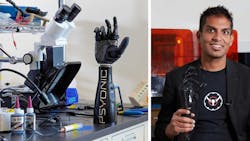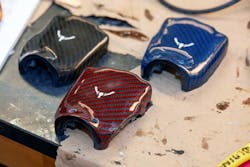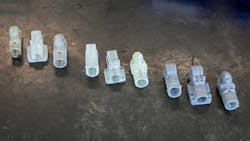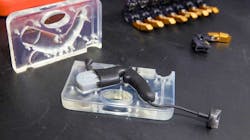Hybrid Manufacturing Techniques Enable Production of a Bionic Hand
Medical device manufacturing has a reputation for demanding high upfront R&D costs. But for one med-tech start-up that reality is not getting in the way of developing a bionic hand that could restore a patient’s mobility at an achievable price point.
The story behind using hybrid manufacturing methods—including 3D printing, injection and silicone molding, as well as CNC machines—in the creation of the Ability Hand was born as much from a need to bring down costs as it was from ingenuity.
Prosthetic hands are out-of-reach for 90% of patients who can’t afford advanced prosthetic arms, highlighted a press release issued by Psyonic and 3D printing company Formlabs. For San Diego-based Psyonic, creating an FDA-registered, Medicare-covered, industry-defining upper-limb prosthesis from scratch would be a defining milestone.
“Some of the biggest challenges we’ve faced is how do we make this hand still low cost for us to manufacture, but more durable than anything else that’s out there?” noted Psyonic’s CEO, Aadeell Akhtar. “And when we first started building these hands, we were 3D printing the entire thing and making it super cost-effective.”
To be next-generation, a prosthesis needs to be “fast to respond to user inputs, tough and durable so as to not break during daily tasks, lightweight so as to not tire the user and cramp their arm, and deliver real, sensory feedback,” asserted Psyonic’s press release.
Lightweight, Durable Materials
While CNC machining, injection molding and initial costs are prohibitive for a start-up, 3D printing could offer a way to prototype rapidly and at a low scale and cost, according to James Austin, Psyonic’s lead mechanical engineer.
“In the early iterations of the carbon fiber mold, SLA 3D printing was actually quite important,” said Austin. “We didn’t have the resources to produce molds for the carbon fiber, for example, by machining. So, what we did instead was we would produce molds using High Temp Resin. This was fragile, but heat resistant, which allowed us to press the carbon fiber sheets into the exact shape we wanted, put them in an oven for high temperature to cure them, and then adhere them to our hand.”
He explained that 3D printed molds for manufacturing carbon fiber parts can reduce costs and lower lead times. The molds can be printed at low cost and within a few hours. Psyonic used High Temp Resin and Rigid 10K Resin to achieve complicated mold shapes with fine details for their early prototyping, short-term tests. High Temp Resin has a heat deflection temperature (HDT) of 238°C @ 0.45 MPa and is able to sustain the heat and pressure of an autoclave.
“If we didn’t like the shape, we just changed it in CAD, put it on the 3D printer again, had another High Temp Resin block come out and we were good to iterate,” Austin said.
But for long-term sustainability, the engineers eventually switched over to machining molds.
READ MORE: At Your Fingertips: Improving Dexterity Through 3D-Printed Skin
Advanced Functionality
Restricted by their budget, the engineers needed to resourceful: They turned to reverse engineering and 3D printers to speed along development and reduce delays in production. “For smaller parts, we actually have the capacity to fairly easily reverse engineer the shape and form, and then simply produce them ourselves in-house,” Austin said.
The Psyonic team also found they needed to mold the fingers in order to improve durability and switched to 3D molds. This method was supported by feedback from hundreds of patients and clinicians who complained about their $50,000 bionic hand breaking.
“They would accidentally hit it on the side of a table and, because the fingers were made out of rigid 3D-printed components, they would just snap at the joints and break,” said Akhtar. “But our own fingers, they’re flexible. When you hit them, they actually flex out of the way and come back. And it was that kind of functionality that we wanted to build into our prosthetic hand to make them more durable than anything else.”
To mold the fingers, explained Austin, the molds needed to be super smooth and printed at high resolution, making SLA (stereolithography) a better fit. Psyonic used Clear Resin, which has a higher resolution than fused deposition modeling (FDM) 3D printers. “We would produce these molds by taking the inverse of the finger or thumb shape that we wanted, subtracting it from a block, adding runners and inlets for the two-part silicone to be injected,” Austin said. “Once that mold had been designed and printed on a 3D printer, we would put a plastic 3D printed bone inside it, which forms the skeleton of the finger.”
This method is not without limitations. Austin explained that Clear Resin can get worn down over time. When that happens, it’s easy enough to print another batch of molds and have them ready within 24 hours, he said.
READ MORE: Bionic Hand Provides Strength and Haptic Feedback
Highest Resolution
Austin said he used the highest resolution possible when printing on the Form 3 (25 microns) for creating both end-use parts and molds. For tough 1500 Resin parts, such as the drivetrains, this is needed because they fit together very precisely. “They have a very tight fit inside the hand and around the motors and gears,” said Austin. “Any variation or tolerance in this could cause the gears to grind or the parts not to fit, so they need to be made as precisely as possible in order to achieve optimal fit and functionality.”
The molds are run at high resolution to ensure smooth surface and washed thoroughly with the Form Wash to get a slick surface. “The smooth result is reflected in the silicone that we mold in those parts afterwards,” said Austin.
Rapid Prototyping
Prototyping plays a significant role in medical device design. Feedback from patients and end-users at this phase is invaluable and medical device manufacturers go through hundreds of prototypes before a part is ready for field testing. Austin noted that there were occasions when he had reworked a design in response to seeing a patient break the device in ways that had not been accounted for.
Austin pointed out the objective was to balance and optimize the manufacturing method. “A lot of prototypes will start out being made in FDM printed plastic or in SLA printed resin, and then once we decide we’re settled on a fairly final design, we may get it remade using, for example, a CNC machine in metal, which is more expensive and more time consuming, but more durable long-term,” he said.
“Some things are perfectly fine to be kept as SLA, they work great in resin. Some things have a bit more durability once we switch them over to metal,” said Austin. “Having all these options means that we can really mix-and-match to optimize for any individual part, to really make sure that we get the best bang for our buck. The lowest manufacturing cost, but the highest performance.”
The next phase of growth for Psyonic will be to focus on the North American market, with the production of Ability Hands ramping in late 2022.
What patients really want is do the normal activities of daily living, noted Akhtar. Advancing the mechatronic interface alone can be is a strong motivator for pursuing advanced innovations in the design of the prosthesis.
Garrett Anderson, a retired U.S. Army sergeant whose right arm was amputated below the elbow following a roadside bombing incident while deployed in Iraq, is one of the first power-users of the Ability Hand. “Earlier this year was the first time I actually could feel touching my daughter’s hand with this prosthetic hand because of the sensory feedback,” he said.
About the Author

Rehana Begg
Editor-in-Chief, Machine Design
As Machine Design’s content lead, Rehana Begg is tasked with elevating the voice of the design and multi-disciplinary engineer in the face of digital transformation and engineering innovation. Begg has more than 24 years of editorial experience and has spent the past decade in the trenches of industrial manufacturing, focusing on new technologies, manufacturing innovation and business. Her B2B career has taken her from corporate boardrooms to plant floors and underground mining stopes, covering everything from automation & IIoT, robotics, mechanical design and additive manufacturing to plant operations, maintenance, reliability and continuous improvement. Begg holds an MBA, a Master of Journalism degree, and a BA (Hons.) in Political Science. She is committed to lifelong learning and feeds her passion for innovation in publishing, transparent science and clear communication by attending relevant conferences and seminars/workshops.
Follow Rehana Begg via the following social media handles:
X: @rehanabegg
LinkedIn: @rehanabegg and @MachineDesign



